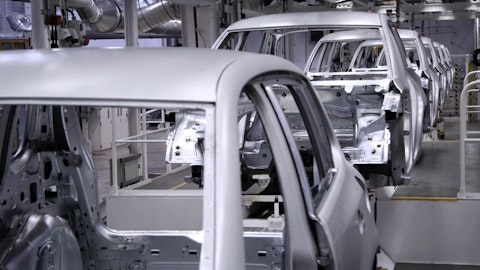Rockwell Automation, Inc. (NYSE:ROK) Q3 2023 Earnings Call Transcript August 1, 2023
Rockwell Automation, Inc. misses on earnings expectations. Reported EPS is $2.66 EPS, expectations were $3.17.
Operator: Thank you for holding, and welcome to Rockwell Automation’s Quarterly Conference Call. I need to remind everyone that today’s conference call is being recorded. Later on the call, we will open up the line for questions. [Operator Instructions] At this time, I would like to turn the call over to Aijana Zellner, Head of Investor Relations and Market Strategy. Ms. Zellner, please go ahead.
Aijana Zellner: Thank you, Julianne. Good morning, and thank you for joining us for Rockwell Automation’s third quarter fiscal 2023 earnings release conference call. With me today is Blake Moret, our Chairman and CEO; and Nick Gangestad, our CFO. Our results were released earlier this morning, and the press release and charts have been posted to our website. Both the press release and charts include and our call today will reference non-GAAP measures. Both the press release and charts include reconciliations of these non-GAAP measures. A webcast of this call will be available on our website for replay for the next 30 days. For your convenience, a transcript of our prepared remarks will also be available on our website at the conclusion of today’s call.
Before we get started, I need to remind you that our comments will include statements related to the expected future results of our company and are, therefore, forward-looking statements. Our actual results may differ materially from our projections due to a wide range of risks and uncertainties that are described in our earnings release and detailed in all our SEC filings. So with that, I’ll hand it over to Blake.
Blake Moret: Thanks, Aijana, and good morning, everyone. Thank you for joining us today. Let’s turn to our third quarter results on Slide 3. We saw good double-digit growth in both sales and earnings this quarter as component shortages continue to ease. Lead times also continued to reduce across our product lines with recovery to pre-pandemic lead times expected for all products by the end of the calendar year. We did miss almost a week of planned shipments in May because of a longer-than-expected changeover to a new third-party logistics supplier at our North American distribution center. Shipments from this distribution center recovered in June and we now have higher capacity in place for Q4 fiscal year 2024 and beyond. Both total and organic sales grew over 13% versus prior year with currency and acquisitions roughly netting each other out.
Currency translation decreased sales by less than a point and acquisitions contributed over a point of growth this quarter. Similar to prior quarters, the split of our sales by business segment, region and industry was largely driven by the composition of our backlog. In the Intelligent Devices business segment, organic sales were up 8% versus prior year. The changeover in our distribution center had the biggest impact on this segment in the quarter. Within the Intelligent Devices segment, Independent Cart Technology continues to be a disruptive technology, and we had several more strategic material handling wins in the U.S. this quarter. The recent launch of our On-Machine Armor Kinetix motion control products adds to our innovative material handling portfolio.
We also had an important win in Europe with SIDEM, one of the world’s leading desalination companies where our PowerFlex drives and services expertise are helping this customer deliver economical and sustainable drinking water to millions of people in developing regions. Software & Control organic sales grew over 24% year-over-year. Logix sales were almost 40% this quarter, reflecting the strong differentiation of our control platform and the continued benefits from supply chain resiliency investments we’ve made over the last year. Another example of our many ways to win within Software & Control is recent success at a well-known global parcel delivery company, where the combination of our awesome industrial PCs ThinManager and View software unseated a long-standing competitor as the customer standardizes its North America facilities on a Rockwell visualization platform.
Lifecycle Services organic sales increased 8% versus prior year. Book-to-bill in this segment was 1.08, led by strong orders in Sensia and our services business. Sensia had another good quarter of orders and sales with multiple large deals across EMEA and Asia. We also delivered higher sequential margins in Lifecycle Services this quarter. Information Solutions & Connected Services sales grew 10% versus prior year. We had multiple wins across our entire Information Solutions portfolio in Q3 and including both our on-prem and cloud-native software. This quarter, one of the world’s top tire manufacturers located in Asia-Pacific, selected Rockwell’s FactoryTalk production center to develop its new global MES platform. Another important IS win in Asia was with a Japanese global leader in HVAC where our cloud-native Plex platform is being deployed on Microsoft Azure at one of their greenfield plants.
The customer chose our SaaS solution to quickly start up a manufacturing execution and quality management system without the need for extensive on-premise hardware, software and support. We saw Plex synergy wins continue to ramp up in the quarter as our strong market access machine is contributing to new SaaS logos. In the quarter, we saw the benefits of our software partnership with PTC with numerous recurring revenue wins through a combination of our Digital Services business and PTC’s ThingWorx visualization platform. Also regarding PTC, we continue to monetize the investment we made in 2018. We now own less than 5% of total shares outstanding and in accordance with the terms of our agreement, I’m stepping off of their Board. Our commercial relationship remains strong and was extended in June.
In Connected Services, we had an important cybersecurity win with ADNOC, the Abu Dhabi National Oil Company. This customer is leveraging our network of security services and expertise along with an intrusion detection system from our partner Dragos to help secure its network infrastructure and comply with cyber governance regulations. Our total annual recurring revenue grew a very strong 17% year-over-year this quarter. Segment margin of 21.1% was flat to last year and in line with our expectations despite the shipment shortfall. Adjusted EPS grew over 13% year-over-year. Backlog is beginning to reduce as lead times improve. Let’s now turn to Slide 4 to review key highlights of our Q3 end market performance. Our discrete sales were up about 10% versus prior year.
Within discrete automotive sales grew mid-teens year-over-year. One of the notable customer wins here this quarter was with the Korean Tier 1 supplier working on an EV battery project for a European brand owner. This customer is using our core automation offerings including motion control to provide tooling for battery thermal management. Another automotive win this quarter was with Jaguar Land Rover where Rockwell was selected to support the JLR electrified architecture for three of their EV body shops in the UK. Semiconductor sales grew high-teens this quarter, building on strength over the last few quarters, we continue to see broader adoption of our wafer transport solutions by the world’s leading semiconductor manufacturers. This quarter, we also had an important Plex win in semiconductor at SOC, Saudi Arabia as the customer implements our smart manufacturing platform at its site in Riyadh.
In e-commerce and warehouse automation sales were down high-teens versus prior year, driven by continued delays in some cancellations at our e-commerce customers. Moving to our hybrid industry segment. Sales in this segment grew 15% year-over-year led by strong growth in food and beverage and tire. Food and beverage sales were up mid-teens versus prior year. We continue to see both greenfield and brownfield investments in this vertical. With one of our most important multi-year wins this quarter focused on a customer’s global fleet modernization program, a leading global food processing company is standardizing over 50 of its sites on our PlantPAx control platform. This competitive DCS win is a testament to our progress in process control applications in both technology and domain expertise.
Life sciences sales grew mid-single digits versus prior year. This industry continues to see strong investments in CapEx and OpEx projects across all regions, both in traditional pharmaceuticals and newer advanced therapy, medicinal products. We had a strategic win with Biosero a member of the BICO Group in North America where our combined technologies increased the speed and accuracy of new drug development. Biosero selected our independent cart technology to automate lab workflows for a cell and gene therapy program. Tire was up over 35% in the quarter. Turning to process industries. Process sales were up 15% year-over-year led by growth in oil and gas and mining. Turning now to Slide 5 in our Q3 organic regional sales. As I said earlier, our growth by region this quarter and for the full year fiscal year 2023 reflects the composition of our backlog rather than the underlying customer demand.
North America organic sales grew about 2% year-over-year against higher comps. Latin America was up 7%. Through Q3, our orders in the Americas are outpacing the rest of the world. EMEA sales grew 34% and Asia-Pacific was up over 44%. We did see an uptick in order cancellations in China this quarter. Let’s now move to Slide 6 fiscal 2023 outlook. We are confident that shipments in the fourth quarter will recover the shortfall in Q3 caused by the distribution center change. Shipments in July were in line with our forecast for the full year. Our fiscal 2023 guidance assumes a total reported sales growth range of 14% to 16%, and we continue to expect organic sales growth of 15% at the mid-point. We now expect the impact from acquisitions and currency to offset each other.
Nick will cover this in more detail later. We have said all along that we expect further normalization of ordering patterns as lead times and constrained products improve, and that’s what we are seeing right now. With improving lead times, machine builders do not need as many months of products on order and are no longer placing unusually large advanced orders. Their incoming orders and front log remain strong and improving component lead times will help them improve their cash flow. We also expect distributor restock orders will pick up as they receive the last constrained items that allow them to clear their committed inventory and complete customer orders. Our order cancellation rates remain low. We now expect our full year fiscal year 2023 orders to be in the $8.5 billion to $9 billion range.
Given this updated order outlook, we now expect to finish the year with about $4.5 billion to $5 billion in backlog with about 80% of that backlog shippable in fiscal year 2024. We expect organic ARR to grow 15%. Segment margin is expected to increase by 160 basis points year-over-year. We are increasing the midpoint of our adjusted EPS guidance by $0.05 and now expect adjusted EPS to grow 25% versus prior year and we now expect 80% free cash flow conversion due to higher working capital. Let me turn it over to Nick to provide more detail on our Q3 performance and financial outlook for fiscal 2023. Nick?
Nick Gangestad: Thank you, Blake, and good morning, everyone. I’ll start on Slide 8, third quarter key financial information. Third quarter reported sales were up 13.7% over last year. Q3 organic sales were up 13.2% and acquisitions contributed 120 basis points to total growth. Currency translation decreased sales by 70 basis points, about three points of our organic growth came from price. Segment operating margin expanded to 21.1% and was in line with our expectations as improved productivity offset lower than expected sales. The 30 basis point year-over-year increase in margin was driven by higher sales, volume and positive price cost partially offset by higher investment spend. Corporate and other expense was $32 million in line with our expectations.
Adjusted EPS of $3.01 was below our expectations due to our shift in shipments from Q3 to Q4. Adjusted EPS grew 13% versus prior year. I’ll cover a year-over-year adjusted EPS bridge on a later slide. The adjusted effective tax rate for the third quarter was 14.1% and in line with the prior year. Free cash flow of $240 million was $87 million lower than prior year, driven by increases in working capital and income tax payments, partially offset by higher pre-tax income. The increase in working capital was primarily driven by higher accounts receivable and inventory. Inventory grew by six days, primarily in finished goods as a result of the shift in planned shipments from Q3 to Q4. One additional item not shown on the slide, we repurchased approximately 220,000 shares in the quarter at a cost of $62 million.
On June 30, $1 billion remained available under our repurchase authorization. Slide 9 provides the sales and margin performance overview of our three operating segments. Organic sales growth was led by software and control, which grew 24% year-over-year. Turning to margins, intelligent devices margin decreased by 290 basis points year-over-year due to higher investment spend, unfavorable mix and higher incentive compensation, partially offset by positive price cost. Segment margin for software and control increased 340 basis points compared to last year on higher sales volume and positive price cost partially offset by higher investment spend. We continue to accelerate top line growth and profitability from acquisitions in the past few years, including Plex, Fiix and ASEM.
Lifecycle services margin was similar to last year and improving sequentially through the year as planned. Our focus on productivity is yielding benefits now and into the coming quarters. We continue to expect lifecycle services margin to expand sequentially and exceed 10% in Q4. The next slide, 10, provides the adjusted EPS walk from Q3 fiscal 2022 to Q3 fiscal 2023. Core performance was up $0.90, excluding increased investment spend of $0.35 on a 13.2% organic sales increase. Incentive compensation was a $0.20 headwind. This year-over-year increase reflects the higher expected bonus payout this year versus a below normal payout last year. The year-over-year impacts from tax, interest expense, currency and share count were each immaterial to EPS this quarter.
Before we turn to our fiscal 2023 guidance, let’s spend a few minutes talking about our orders trends on Slide 11. We think it will be helpful to provide more color on our orders progression over the last couple years and going forward. First, in fiscal 2020, we saw reduced orders caused by the constraints on customers operations and uncertainty that the pandemic created. Then in fiscal 2021 and fiscal 2022, we saw increased orders driven by the combination of three things. First, historically high levels of investment in certain verticals like EV and semi, as well as an increasing need for more automation to address workforce shortages and business resiliency. Second, catch up on projects that many of our customers deferred during fiscal year 2020.
And three, large advance orders due to extended lead times caused by component shortages. In fiscal year 2023, we are continuing to see strong underlying demand, but we are now seeing the long anticipated moderation in orders driven by our improving lead times for products. As we stated earlier, we expect lead times to continue to normalize in the next two quarters and we expect virtually all of our product lead times to be back at pre-pandemic levels by the end of calendar year 2023. Once our lead times are back at normal levels, we expect customer orders to closely align with the strong underlying demand. I think it’s worth noting that over the fiscal year 2019 to fiscal year 2023 time period encompassing the ups and downs of the order cycle, we will have grown revenue at a compound annual growth rate of 8% plus a backlog that is more than tripled during that timeframe.
Let’s now move to the next Slide 12, guidance for fiscal 2023. We are increasing the midpoint of our reported sales guidance from 14.5% to 15%. We expect organic sales growth in the range of 14% to 16% and we now expect a full year currency headwind of 100 basis points, 50 basis points better than our previous guidance. This updated outlook reflects the weakening of the U.S. dollar in recent weeks. We continue to expect volume to add 10 points of growth and price to add 5 points of growth, and we still expect full year segment operating margin to be about 21.5% unchanged from prior guidance. Our updated guidance still assumes full year core earnings conversion of close to 40%. We continue to expect the full year adjusted effective tax rate to be around 17.5%, unchanged from our prior guide.
We are narrowing our adjusted EPS guidance range to $11.70 to $12.10. This increases the midpoint of our EPS guidance to $11.90, up $0.05 from prior guidance and up 25% from last year. The $0.05 increase is driven by currency. We now expect full year fiscal 2023 free cash flow conversion of about 80% of adjusted income. This updated guidance reflects the new calendarization of our revenue and our updated projection of inventory days on hand. We do expect our inventory days on hand to drop by the end of the year to 125 days. This will be lower than the approximately 130 days of inventory we had at the end of fiscal year 2022, but will likely not reduce to the 112 days we originally expected. Our outlook for cash tax payments also increased as we realized capital gains on our sales of PTC shares.
Income tax payments tied to these gains are reflected in our free cash flow results. A few additional comments on fiscal 2023 guidance. Corporate and other expense is still expected to be around $120 million. Net interest expense for fiscal 2023 is still expected to be about $130 million, and we’re still assuming average diluted shares outstanding of 115.6 million shares. With that, I’ll turn it back over to Blake for some closing remarks before we start Q&A. Blake?
Blake Moret: Thanks, Nick. As we continue to stay close to end users, machine builders and distributors, a few key themes emerge. First, demand remains strong. We’ve mentioned softness in e-commerce and in parts of the Chinese economy, but investment by end users and machinery builders continues across the majority of regions and serve verticals. Second, the global supply chain is improving, but it will take some months to flush the inefficiencies that have built up over the last few years, especially inventory. This is seen at machine builders, distributors and in our own operations. Third, the opportunities for automation to play a strategic role in our customer success have never been higher. Workforce scarcity, American shoring of manufacturing and the premium being placed on business agility are all positive reads for Rockwell.
We’re moving fast to meet these needs with new capacity and capabilities. It’s hard to believe, but our Annual Automation Fair and Investor Day are only about three months away, and you should look forward to hearing more about the exciting next leg of our journey. I want to thank all our employees and also our unmatched distributors who have worked so hard to bring us to this point and who collectively make the difference at our customers. Aijana will now begin the Q&A session.
Aijana Zellner: We would like to get to as many of you as possible, so please limit yourself to one question and a quick follow-up. Julianne, let’s take our first question.
See also 10 Best Sectors To Invest In Long-Term and 10 Oversold NASDAQ Stocks to Buy.
Q&A Session
Follow Rockwell Automation Inc (NYSE:ROK)
Follow Rockwell Automation Inc (NYSE:ROK)
Operator: Thank you. [Operator Instructions] Our first question comes from Andy Kaplowitz from Citigroup. Please go ahead. Your line is open.
Andy Kaplowitz: Good morning, everyone.
Blake Moret: Hey, Andy.
Andy Kaplowitz: Blake or Nick, can you give us more color into the order of visibility you have that allowed you to construct Slide 11. If I add all the timing, it looks like you expect a relatively significant orders inflection higher, maybe even in the first half of 2024. And it also looks like you think orders could reach the peak levels again, that you saw in 2022. Is that what you’re attempting to say? And then what markets would you most likely see an uptick in bookings?
Blake Moret: Yes. Andy, there’s a few factors that contribute to that outlook for orders. First are the continued high investment levels and some important verticals for us. We see continued investments as we track new CapEx announcements in areas like semiconductor, in EV, in renewables, while we see a general focus on automation at many of our other verticals like food and beverage, life sciences, energy and so on. We also have had a number of conversations with customers and distributors that give us a consistent view that demand remains strong. As I and members of my team have talked directly to machine builders and end users, they’re all proceeding with plans based on the consistent demand for their products. We described in my remarks what we’re seeing in terms of machine builders who are not placing the unusually large advanced orders that they did of say a year ago.
And we’ve also had direct conversations with our distributors and in North America, some of our largest distributors are actually seeing year-over-year order increases. So again, that consistently strong demand picture informs that view that we showed you on Slide 11 of orders recovering, complimenting the remaining strong backlog.
Andy Kaplowitz: Thanks for that Blake. And then Nick, can you quantify how much impact the change in U.S. distribution you made had on sales and earnings in Q3? And then specifically could you go over how to think about margin moving forward for your segments? It looks like you talked about the change impacting intelligent devices, but moving forward should we be thinking 20% to 21% for that segment, which was your prior guide? And then conversely, software margin continues to go up, can you sustain mid-30% margins in that segment?
Nick Gangestad: Yes. As far as the sales impact, we had originally planned when we guided what we expected for growth expectations between Q3 and Q4, we had expected some disruption. We were planning close to a week of disruption that this would be causing in the loss of capacity during our third quarter. That ended up extending by several more days in terms of the total impact it had on us. All in something in the range of $50 million to $100 million of revenue is I think a good ballpark to think about of what we’re seeing of a shift of revenue there between the third and fourth quarter from what we were anticipating three months ago. And then in terms of margin progression, Andy, for the rest of this year, we continue to expect that margins will expand.
We think fourth quarter margins will be our highest margin for the year. We continue to expect to see strong margins in our Software and Control business, something similar to what we’ve been seeing the last couple quarters. And as I’ve said for the last couple quarters, we expect sequential margin improvement in lifecycle services. We expect that will be over 10% in Q4. And then intelligent devices as we recapture some of that revenue that shifted from Q3 to Q4, we think added revenue there will be bringing that margin up from where we were in the third quarter. All in, we still expect ITV smart intelligent devices margin to be a little under 20% for the full year, software and control to be well over 30% and lifecycle services will be below 10% for the full year.






